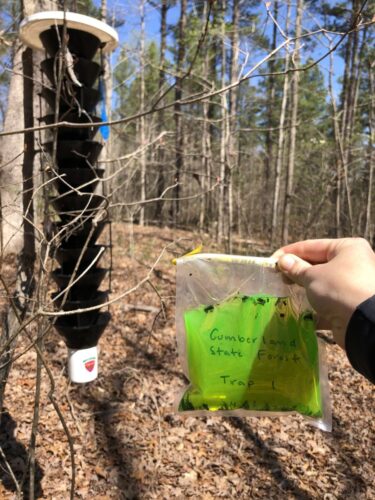Thinning Out Southern Pine Beetle

By Katlin Dewitt, VDOF Forest Health Specialist
The southern pine beetle (SPB) is the most destructive native insect that threatens pine forests in the Southeast. These tiny insects, about the size of a grain of rice as adults, are especially harmful due to the complex system of pheromones (insect “scents” that are specific to a species) they utilize to find host trees and aggregate. Pheromones allow populations to build up quickly within a pine stand, often leading to classic beetle spots comprised of dead and dying trees.

Aerial view of a classic SPB spot
The VDOF forest health program monitors SPB populations with traps each spring, starting at the time the redbuds bloom. Traps are placed in high-risk locations (areas with a significant volume of pine) and are baited with pheromones. These traps are checked weekly for four weeks and samples are sorted, looking at the number of SPB and their associated predator, a clerid beetle. The relative number of these two insects is used to determine if southern pine beetle populations are increasing or decreasing. This information allows foresters and landowners to be more alert and act quickly should they see SPB.

SPB trap and sample
In addition to monitoring, certain silvicultural practices can reduce the risk of southern pine beetle attack in a pine stand. Pre-commercial thinning is the most effective management strategy to prevent SPB damage. How can forestry practices influence the population of tiny beetles? A lot of it goes back to those tiny clouds of pheromones the beetles rely on to communicate. When stands are overstocked and densely packed, these “scents” can become concentrated and highly aromatic to the beetles, drawing more and more in, thereby creating an SPB spot. A thinned stand allows more air movement, which breaks up the clouds of beetle perfume and makes beetle aggregation more difficult. Thinning also increases the health of the stand, and healthier trees are better able to resist beetle infestation.

Pine stand thinned using Pine Bark Beetle Program cost-share funds
VDOF has a Pine Bark Beetle Prevention Program which is funded by the US Forest Service Southern Pine Beetle Prevention and Restoration Program. VDOF uses this money to operate a cost-share program available to landowners and loggers for specific forest management practices that improve the health of managed pine stands and reduce the risk of SPB infestation. The three cost-share programs offered are:
- Pre-commercial thinning: Assistance through this program will cover 60% of direct project costs of pre-commercial thinning on parcels greater than 5 acres, with trees no older than 15 years, and tree density before thinning greater than or equal to 800 stems per acre. Cost-share payments cannot exceed $105/acre and $10,000 per federal fiscal year.
- Longleaf restoration: Longleaf pine is a native pine species that has been historically diminished in Virginia and is somewhat resistant to attack from SPB. To aid in restoring these stands, this program pays 60% of total direct costs associated with site preparation, planting, or post-planting treatments within the first five years of plantation establishment. Cost-share payment cannot exceed $225/acre and $10,000 per federal fiscal year.
- Logger incentive program: This program reimburses certified SHARP loggers in Virginia who conduct first commercial thinning on smaller stands, 5-25 acres in size, with trees 12-22 years of age. Assistance covers 50% of itemized logging costs, not to exceed $2,000/parcel, and no more than 5 applications (or $10,000) per federal fiscal year.
To learn more about how you can protect your forest from the southern pine beetle, check out the prevention program information, or reach out to your local area forestry staff.


